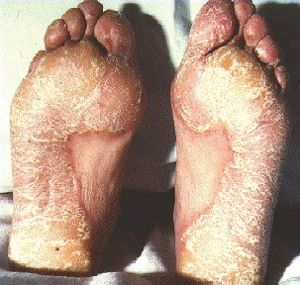Psoriasis
Definition
A scaly and inflammatory rash caused by hyperproliferation of keratinocytes.
Epidemiology
Affects both sexes pretty much equally and has a prevalence of around 2% in the UK population. It peaks at 15-20 and 55-60.
There is some genetic link: you have a 1 in 10 risk with one parent with the disease, and 1 in 2 if both do.
65% have a mild form of disease, but around 7% of patients get a seronegative arthropathy
Pathophysiology
The causes are multifactorial - genetic, infective in some cases (kicked off by streptococcus), stress, trauma, drugs (alcohol, beta-blockers, NSAIDs, antimalarials, lithium).
THere are two mechanisms; the first is hyperproliferation of keratinocytes in response to cytokines. These form what are referred to as psoriatic plaques. The time it takes for epidermal cells to move through the epidermis (transit time) changes from 30 days to about 2-3 days. The epidermis becomes 3-5 times thicker than usual (acanthosis); and starts to form "rete" ridges (arrowheads). This layer thickens further forming the stratum corneum".
The second mechanism is inflammatory infiltration. There is more intracellular adhesion in the epidermis and it is infiltrated by neutrophils and lymphocytes. You can get (Munro's) microabscesses in the stratum corneum. Finally, you get dilated, tortuous capillaries in the outer dermal layer. When scales are removed it causes pin-point bleeding called Auspitz sign.
Clinical Features
Psoriatic plaques are red plaques, itchy with silvery scales. It classically occurs on extensor surfaces of elbows, knees, plus scalp and sacrum.
Flexures are frequently affected - axillae, groin, submammary, umbilicus - though they are usually not scaly. Smaller plaques (guttae of guttate psoriasis) are often seen in children.
Other signs:
- Nails - pitting, onycholysis (seperation from nailbed)
- Pustules variant - can appear on the hands and the feet in this variant of normal psoriasis
- Koebner phenomenon - plaques follow lines of trauma
- Auspitz sign - pin-point bleeding on scale removal
Psoriasis can develop into psoriatic arthropathy in about 7%.
Some people can have an erythrodermic psoriasis episode - can cause severe systemic illness (fever, raised WCC, dehydration). Can be due to steroid withdrawal. Lose ability to control temperature, etc. Need to be admitted.
Management
Topical
Topical treatments are messy, and difficult to use well, and work slowly.
- Emollients - This is the first step. Chuck it on, it'll loosen things up and soften skin.
- Tar - topical ointment but messy so generally only used in hospital. Applied twice daily.
- Vitamin D analogues (calcipotriol/tacalcitol) used in short courses.
- Topical steroids - uses in short courses.
- Dithranol - topical cream applied for 20-30 minutes (start at 0.1% up to 1%). Side-effects: burning (don't use for flexures) and staining (not for face).
Phototherapy
Light treatments help around 80% of patients, but it requires attendance 3 times a week for 8 weeks. Most relapse within 6 months.
Systemic
- Acitretin - retinoid, 30% respond, risks++
- Methotreaxate - antimetabolite, 70% respond, risks+++
- Ciclosporin - immunosuppressant, 80% respond, risks++++
There are some biologics medications, which are very expensive, and still in testing - but currently working in 60% of patients who it didn't work for.
Prognosis
The general aim is to reduce the disease to about 10% as bad as it was to start. The patients would like 0%. They will be disappointed, general.
